Human Flower Project
Imagining Derek Jarman’s Garden
‘The garden is off’ and John Levett is going with it.
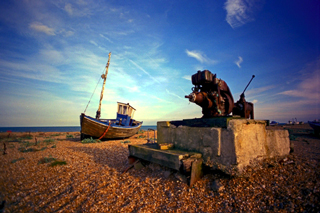
Dungeness Beach
Photo: John Levett
By John Levett
A few months ago I was paid a fine compliment by one of the college students with whom I have had the privilege of working. She is Korean and an outstanding photographer. After a two-hour forum she came to me and said: “I don’t understand what you say but I like it very much.” I knew what she meant and I thanked her. The session had been a useful rambling affair in which one idea followed another without any seeming connection, without direction or goal and, importantly, without any consequence. I’m a Visiting Fellow this semester. There are no course credits for these sessions, no papers to file on time, no reading list to be marched through; just an opportunity to take ideas and see if they fit. I think we’d fit the idea of the university in the mind of Newman.
The session in question had involved extemporising on visual representations of memory and whether such representations are equivalent to trying to represent materiality. My view at one point was that any representation of memory should (as with materiality) equate to its fading and disappearance which, in turn, led me to thinking that the singular thought and acknowledgment of a memory would be a sufficient representation of it. I then thought that this sounded too much like my very own personal Onoesque ‘Fluxus Moment’ and I ought to ramble off somewhere else.
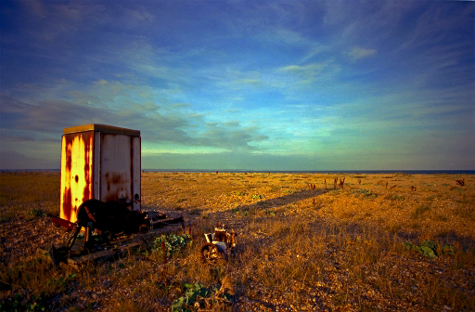
Dungeness Beach
Photo: John Levett
Matters of memory seem to be concerning me more and more and I’m not keeping up with the pace. An example. I’m having to draw a line underneath the list of titles that I think I should re-read. I won’t list them but the usual suspects are there. If you were around a college any time between 1950 and 1970 then you’ll probably have your own list and I’m guessing there’d be a lot of overlapping between yours and mine.
This isn’t a matter of re-reading because I’ve totally forgotten the content; it’s more a matter of context. Much of what I read in my student years was contemporary or nearly so; now these works are historical tracts — This Sporting Life, Room at the Top, A Taste of Honey, A Kind of Loving, Saturday Night and Sunday Morning — films all but the urtexte gives insights into a rare kingdom (one obsessed with the rituals of keeping warm, protocols within the ceremony of building and lighting a domestic fire and stoking it to its last ember). The same goes for histories — reading them for the historiography more than the history.
Even my photographic work is taking on a similar patina of historical artefact. This past couple of weeks I’ve been sorting some shelves in my study—the sort of sorting that involves taking everything off the shelves then putting it all back in the same place. When I came back into photography in 1996 I began as the beginner should—all negatives (negatives?) filed, camera used noted, exposure recorded, test strips & contact sheets included. That fell away after a brief blooming but all the work of, now, fifteen years ago is still boxed and filed—a record of a new life in the building of it.
Which brings me to Derek Jarman. Shortly.
.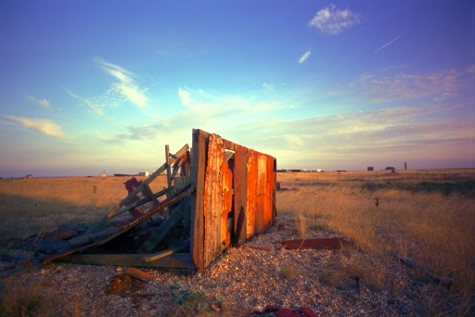
Dungeness Beach
Photo: John Levett
In 1954 I went away from home for the first time (at lease the first time that I can remember). I was still at Junior School and went away for a week to Romney Marsh. The place we stayed was like a holiday camp but was in fact a former army barracks disused since the war but still complete with camp beds and running cold water. For the timid child that I was, lasting a week without tears and walking home was some sort of achievement. More than that, it left an impression of landscape upon me that never left. I didn’t return there until almost fifty years later.

Dungeness Beach
Photo: John Levett
In the years that had passed between, visits to the Marsh frequently surfaced in my mind and its place in the iconography of my early years never faded. I wasn’t disappointed when I returned and spent a week walking, cycling and sitting in it. It was 2001 and I had ordered a hand-built bike from Witcomb’s in Deptford in south London. As a kid I used to go down to Witcomb’s just to look at the frames being made and promising myself one. Taking me & Witcomb down to the Marsh fitted perfectly.
Back to Derek. I’ve always had a great admiration for Derek Jarman: not just the film and design but the way he lived his life and the way he lived through its passing. I love too his writing—paying attention to every commonplace, taking joy in the singular success, remembering first encounters (“I was frightened by dandelions as a child.”), celebrating the problem, documenting the inhabitants.
The garden that he built at Dungeness was made during his long dying. That takes some doing. There are times some mornings when I sit unable to make a move amongst all the options open to me to start the day and knowing that taking up one task is going to leave another and will the other ever get done. It’s a surprise that I’m a gardener. Gardens take constant attention; not necessarily hard graft but just the act of looking. My first rose came on the sixth of April this year. For all the alarm of our long winter and how it would push the growing back; for all the angst that I took a fall just as I felt myself arrogantly ahead of the season—here was Golden Chersonese a week earlier than any season I’ve had here.
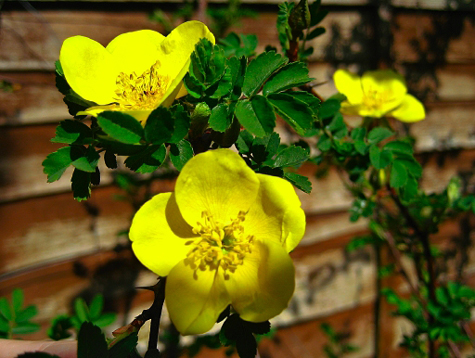
Rosa ecae ‘Golden Chersonese’
Photo: John Levett
I’ve tried hard over the last month to get into the garden and fuss about every day—tying in, hoeing out, sweeping up, laying down; looking at plants rather than a garden, trying to take time and be in the place.
Here’s a passage from Derek Jarman in May in the last year of his life whilst he was being treated at St. Bartholomew’s Hospital in London: “It makes me sad to be lying here with all these young men dying in the spring sunlight….
“Bart’s let me off the drip and Howard and I took off to Dungeness. The day was grey when we set out; we drove down the lanes in the shimmering green of May. Time brings a uniformity to the spectrum of green. Along the verges of the lane are white ramsons, purple orchid, buttercup and bluebell. Up hill, down dale we go to Prospect Cottage, which grows like a tree — more beautiful the older it becomes. The garden is fresh and green as the lanes; it is filled with the flowers of spring: some wonderful tulips: crimson and yellow with a frill, and a deep purple one which sways above the luxuriant tawney wallflowers, the first white campion, blue-eyed forget-me-nots and banks of marigolds; the Crambe cordifolia and maritima are in bud, as are Mrs Sinkins pinks. The dragon-toothed rocks have almost disappeared, the garden is off, the gun of spring fired. The artichoke outside my window has fourteen buds and is shoulder high, the huge thistles have filled out, the roses are all in leaf, the sages are in bud, the everlasting peas sprawl around lazily across the shingle. The gorse, which took a battering, is sprouting.”
“…the garden is off…” That’s how it is, isn’t it? That moment of the season when everything arrives and we have to pay attention because it’ll soon be past us. And there I am trying to get ahead; tick off ‘Garden done.’ There’s not much space to walk in my plot and the nesting blackbirds make part of it off-limits but I’m trying to ‘walk the garden.’ Do nothing but take a step & stop. I’m never going to achieve satori when I’m still at base camp on Desolation Peak but paying attention is the goal—allowing the ‘doing’ to take its place without being the centre of attention.

Dungeness Beach
Photo: John Levett
Where I’m trying to arrive at is the ‘idea’ of the garden. I read a lot about gardens and gardening but I sometimes wonder if I either don’t take much of it in or take the wrong stuff from it. Derek Jarman had the right stuff of gardening. He had an acceptance of limits and then threw them away. He knew or learnt what went where, what worked, what didn’t and what didn’t but would if it just got shifted a tad. But above and beyond all that he brought his whole sensibility to both the creation of it and his comprehending of it. The person and his creativity were one; there was no dividing wall between himself and what he did. The creative was all there was and that applied to everything—friendships, filming, gardening, designing, cooking, walking, writing. No compartments. Everything was himself.
I think that, up to now, my garden has been the arena of manual labour. Even when sitting, reading and writing there I’ve still one eye on the next job. It’s almost as if it’s been something apart from me. The jolt-metaphorical came when I had the jolt-physical last Autumn when “I just had to!” complete the rambler pruning before November and took the dive. I read a lot of Beth Chatto’s writing during the Winter, some bits of Vita that were new to me, Christopher Lloyd too as well as going over some old favourites.
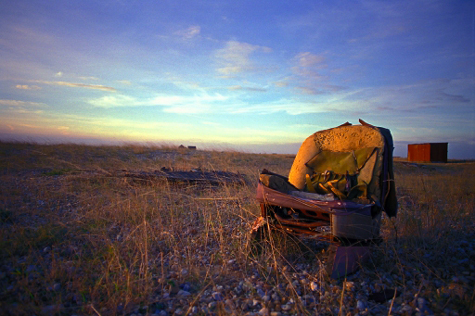
Dungeness Beach
Photo: John Levett
The common feature of them all takes me back to my photography. I was talking with a group of students earlier this week and remaking that my photography was of a piece with the detour that enabled it; that the ‘idea’ of the detour was a ‘life performance’ and that any images that arose from my ‘performing’ the detour were incidental to the event and this applies to these gardeners and most comprehensively to Derek Jarman—he ‘performed’ his ‘idea’ of his garden; he was at one with the wholeness of it all—no joins visible.
I have no photographs of Derek Jarman’s garden. I thought it would be an intrusion; like walking though the front door and snapping the kitchen.

